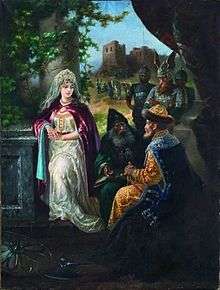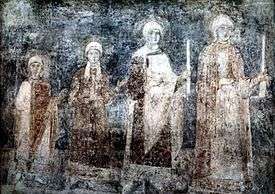Ingegerd Olofsdotter of Sweden
| Ingegerd Olofsdotter | |
|---|---|
| Grand Princess consort of Kievan Rus' | |
 | |
| Grand Princess consort of Kievan Rus' | |
| Tenure | 1019–1050 |
| Born |
1001 Sigtuna, Sweden |
| Died | 10 February 1050 (aged 48/49) |
| Burial | Saint Sophia's Cathedral, Kiev or Cathedral of St. Sophia, Novgorod |
| Spouse | Yaroslav I the Wise of Kiev |
| Issue |
Elisiv, Queen consort of Norway Anastasia, Queen consort of Hungary Anne, Queen consort of France Vladimir of Novgorod Iziaslav I Sviatoslav II Vsevolod I Igor Yaroslavich perhaps Agatha, wife of Edward the Exile |
| House | Munsö |
| Father | Olof Skötkonung |
| Mother | Estrid of the Obotrites |
Ingegerd Olofsdotter of Sweden, also known as Irene, Anna and St. Anna (1001 – 10 February 1050), was a Swedish princess and a Grand Princess of Kiev. She was the daughter of Swedish King Olof Skötkonung and Estrid of the Obotrites and the consort of Yaroslav I the Wise of Kiev. Ingegerd or St. Anna is often confused with the mother of St. Vladimir “the Enlightener” of the Rus. This is mainly because Ingegerd and Yaroslav also had a son named Vladimir. However, St. Vladimir was the father of Ingegerd’s husband Yaroslav I “the Wise”, thus making her St. Vladimir’s daughter-in-law. St. Vladimir was the son of Sviatoslav and Malusha.[1]
Biography


Ingegerd was born a princess in the court of King Olof Skötkonung. In 1015, after Olaf II of Norway assumed the throne as King of Norway, he proposed a royal marriage alliance. In 1016, noblemen of both countries tried to arrange a marriage between King Olaf and Princess Ingegerd. Olof Skötkonung agreed at first but later he reneged. Rather he agreed to the marriage of his daughter, Astrid Olavsdatter to King Olaf. [2][3][4]
Olof Skötkonung subsequently arranged for the marriage of Princess Ingegerd to the powerful Grand Prince Yaroslav I the Wise of Novgorod with whom Sweden had a flourishing trade relationship. The marriage took place in 1019. [5]
Once in Kiev, Ingegerd had her name changed to the Greek Irene. According to several sagas, she received as a marriage gift Ladoga and adjacent lands, which later became known as Ingria, arguably a corruption of Ingegerd's name. She arranged for her father's cousin, jarl Ragnvald Ulfsson, to rule in her stead.[6] [7]
Together Ingegerd and Yaroslav had six sons and four daughters; three of the latter becoming Queens of France, Hungary, and Norway. The whole family is depicted in one of the frescoes of the Saint Sophia.
Death and burial
Ingegerd died on 10 February 1050. Upon her death, according to different sources, Ingegerd was buried in either Saint Sophia's Cathedral in Kiev or Cathedral of St. Sophia in Novgorod.
Sainthood
Ingegerd initiated the building of the Saint Sophia's Cathedral in Kiev (foundation laid in 1037). She also initiated the construction of Cathedral of St. Sophia in Novgorod (built between 1045 and 1050). Ingegerd was later declared a saint under the name of St. Anna in Novgorod and Kiev. The reason for her sainthood was that she initiated the building of both cathedrals in Kiev and in Novgorod together with many other good deeds.
The following was stated by the church in reference to her sainthood:
St. Anna, Grand Duchess of Novgorod, She was the daughter of Swedish King Olaf Sketktung, the "All-Christian King," who did much to spread Orthodoxy in Scandinavia, and the pious Queen Astrida.
In Sweden she was known as Princess Indegard; she married Yaroslav I “the Wise“, Grand Prince of Kiev, who was the founder of the Saint Sophia Cathedral in 1016, taking the name Irene.
She gave shelter to the outcast sons of British King Edmund, Edwin and Edward, as well as the Norwegian prince Magnus, who later returned to Norway.
She is perhaps best known as the mother of Vsevolod of , himself the father of Vladimir Monomakh and progenitor of the Princes of Moscow.
Her daughters were Anna, Queen of France, Queen Anastasia of Hungary, and Queen Elizabeth (Elisiv) of Norway. The whole family was profoundly devout and pious.
She reposed in 1050 in the Cathedral of Holy Wisdom (St. Sophia) in Kiev, having been tonsured a monastic with the name of Anna.
As saint, her hymn goes:
And 4 stichera, in Tone I: Spec. Mel.: Joy of the ranks of heaven
O joy of the Swedish people, thou didst gladden the Russian realm, filling it with grace and purity, adorning its throne with majesty, lustrous in piety like a priceless gem set in a splendid royal crown.
Named Ingegerd in the baptismal waters, O venerable one, thou wast called Irene by thy Russian subjects, who perceived in thee the divine and ineffable peace; but when thou didst submit to monastic obedience, thou didst take the new name, Anna, after the honoured ancestor of Christ, the King of kings.
Wed in honourable matrimony, O holy Anna, thou didst live in concord with thy royal spouse, the right-believing and most wise Prince Yaroslav; and having born him holy offspring, after his repose thou didst betroth thyself unto the Lord as thy heavenly Bridegroom.
Disdaining all the allurements of vanity and donning the coarse robes of a monastic, O wondrous and sacred Anna, thou gavest thyself over to fasting and prayer, ever entreating Christ thy Master, that He deliver thy people from the all want and misfortune.
Feast days: 10 February, 4 October.
Children
Ingegerd had the following children
- Elisiv of Kiev, queen of Norway[8]
- Anastasia of Kiev, queen of Hungary
- Anne of Kiev, queen of France[9]
- (possibly) Agatha, wife of Edward the Exile
- Vladimir of Novgorod
- Iziaslav I of Kiev[10]
- Sviatoslav II of Kiev[11]
- Vsevolod I, Prince of Kiev[12]
- Igor Yaroslavich
References
- ↑ Thomas Arentzen. "Hellige Anna Av Holmgard (1001 – 1050)". Kirkeside/NO. Retrieved May 1, 2018.
- ↑ "Ingegärd – den heliga Anna av Novrograd". ortodoks.org. May 14, 2008. Retrieved May 1, 2018.
- ↑ Claus Krag (May 14, 2008). "Astrid Olavsdatter". Norsk biografisk leksikon. Retrieved May 1, 2018.
- ↑ "Olav den Hellige - Norges evige konge". ortodoks.org. Retrieved May 1, 2018.
- ↑ Samuel Hazzard Cross (April 1929). "Yaroslav the Wise in Norse Tradition". Speculum. 4: 181.
- ↑ Sven H. Gullman (May 14, 2008). "Irina av Kiev och den heliga Anna av Novgorod". svenhgullman.nu. Retrieved May 1, 2018.
- ↑ "Ragnvald Ulfsson". Nordisk familjebok. 1915. Retrieved May 1, 2018.
- ↑ Claus Krag. "Ellisiv, Dronning". Norsk biografisk leksikon. Retrieved May 1, 2018.
- ↑ "Anne of Kiev". columbia.edu. Retrieved May 1, 2018.
- ↑ "Iziaslav Yaroslavych". Canadian Institute of Ukrainian Studies. Retrieved May 1, 2018.
- ↑ "Sviatoslav II Yaroslavych". Canadian Institute of Ukrainian Studies. Retrieved May 1, 2018.
- ↑ "Vsevolod Yaroslavych". Canadian Institute of Ukrainian Studies. Retrieved May 1, 2018.
Bibliography
- Lars O. Lagerqvist (1982). "Sverige och dess regenter under 1.000 år" (in Swedish). Albert Bonniers Förlag AB. ISBN 91-0-075007-7.
External links
- "Rus - Rulers". Xenophon-mil.org. Retrieved 2017-03-15.
- "Ingegerd Olofsdotter". Historiska-personer.nu. Retrieved 2017-03-15.
- "Commemoration of Our Venerable Mother Anna, Wonderworker of Novgorod". Orthodoxengland.org.uk. Retrieved 2017-03-15.
- "St. Anna of Novgorod | Antiochian Orthodox Christian Archdiocese". Antiochian.org. Retrieved 2017-03-15.
- "The Shepherd 11, October 2005". Webcache.googleusercontent.com. 2017-01-19. Archived from the original on 2008-10-13. Retrieved 2017-03-15.
| Royal titles | ||
|---|---|---|
| Vacant Unconfirmed predecessor Title last held by Anna Porphyrogeneta |
Grand Princess consort of Kiev 1019–1050 |
Succeeded by Gertrude of Poland |